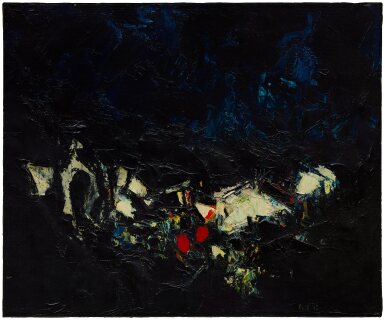Modern & Contemporary South Asian Art
Modern & Contemporary South Asian Art

Sayed Haider Raza
La Nuit
Auction Closed
September 26, 03:20 PM GMT
Estimate
250,000 - 450,000 GBP
Lot Details
Description
Sayed Haider Raza
1922 - 2016
La Nuit
Oil on canvas
Signed and dated ‘RAZA ‘62’ lower right and further signed, dated, titled and inscribed ‘RAZA / P_417 ' 62 / "La Nuit" / 15F’ on reverse
54 x 65 cm. (21 ¼ x 25 ⅝ in.)
Painted in 1962
Collection of Dr Jean-Louis Amiel
Ader Nordmann, Paris, 10 December 2014, lot 186
Private Collection, Australia
Saffronart, Spring Online Auction, 27-28 March 2019, lot 29
Private Collection
Acquired from the above, 2023
A. Macklin (ed.), SH Raza, Catalogue Raisonné, Volume I (1958 - 1971), Vadehra Art Gallery & The Raza Foundation, New Delhi, 2016, illustration p. 82
"... the chapels, churches and crosses [of the French countryside] touched me very deeply. I wanted my paintings to express the feeling of fervour and human tension that burned within me."
- Sayed Haider Raza
(M. Imbert, Raza: An Introduction to his Painting, Rainbow Publishers Ltd., New Delhi, 2003, p. 37)
Thick with impasto and executed with intense contrast and expressive brushstrokes, La Nuit is a masterwork from Sayed Haider Raza's early 1960s practice. Painted in 1962, this canvas dates to a pivotal moment in the artist’s career, before he shifted from oil to acrylic and from recognizable scenes to pure abstraction. In the present work, Raza deftly navigates the separation between representation and the intangible, to capture the beauty and serenity of the night.
Over the course of the mid to late 1950s, Raza’s paintings of the villages, churches and terrain of the French countryside became increasingly expressive. The painter’s planes of light ruptured and his palette gained a feverish intensity. As Raza’s compositions became more abstract, so did the theme. Time - its passing and its effect on the material world - became his recurring subject. Day, night, dawn and dusk, along with the changing seasons, were important inspirations, revealing the unending sequence of light and dark. Raza's free and expressive brushwork from this period mirrored the fleeting notion of time and the imperceptible yet continuous pulse of life.
In the current lot, the ground of the canvas is a thickly applied, intense profusion of midnight blue. Raza's palette knife illuminates the darkness with daubs and strokes of white, yellow and red, creating the suggestion of a hillside village. The settlement is alight, perhaps from bright moonlight or a strike of lightening, and a subtle glow is cast into the sky above.
La Nuit powerfully bridges the divide between Raza’s abstracted landscapes of the 50s and his profoundly Abstract Expressionist style of the mid-60s.
You May Also Like










